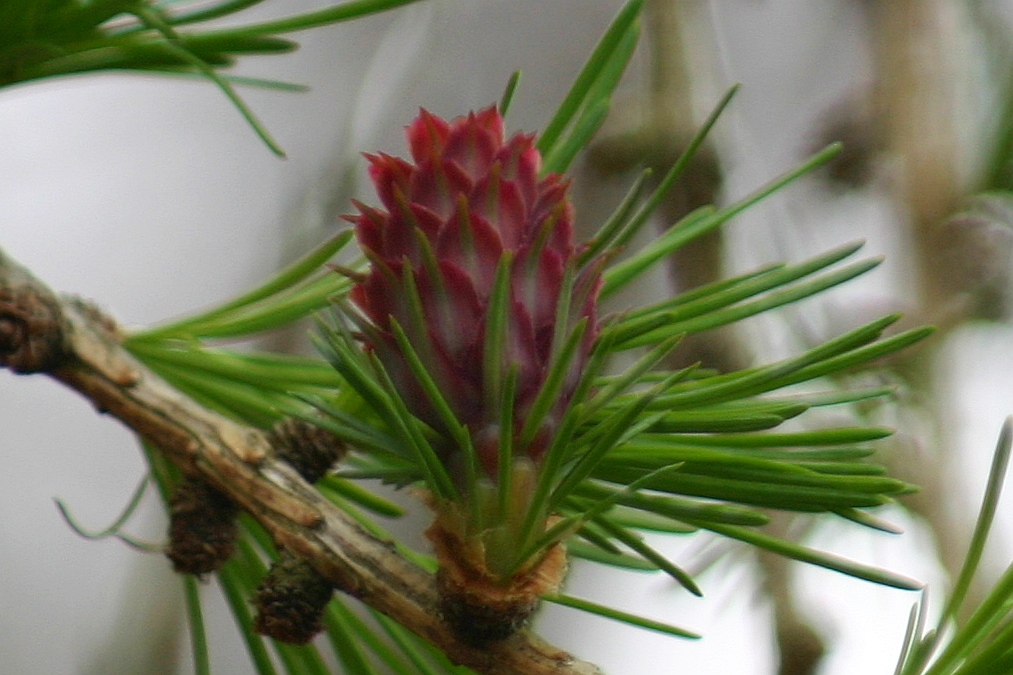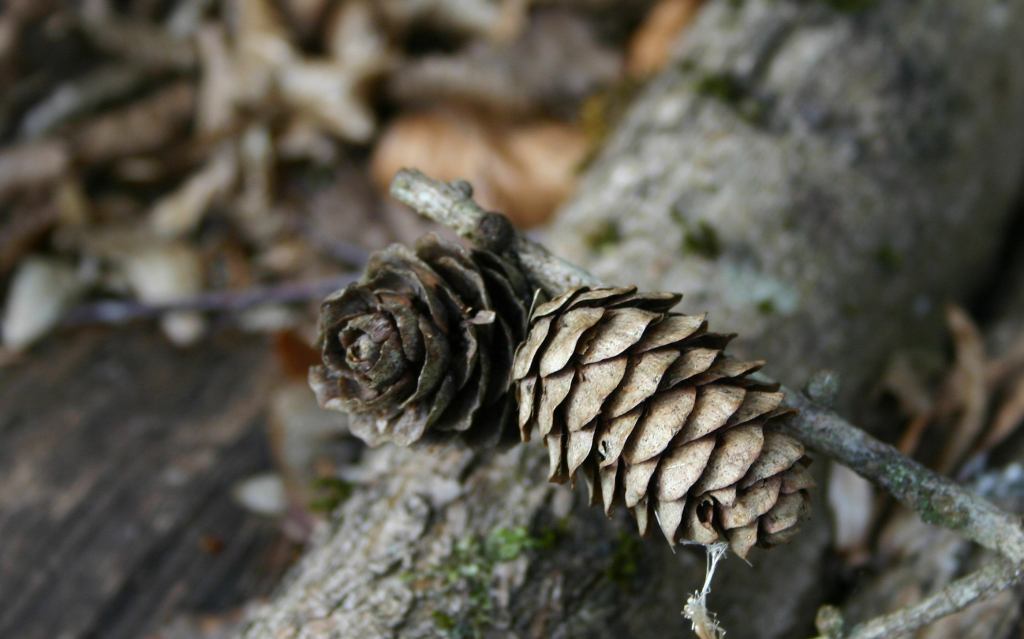Larch
Larix decidua
~~~
For 2012 the Dr. Silvius Wodarz Foundation has chosen the European Larch, Larix Decidua, as Tree of the Year for Germany.
Larches are very graceful trees, and their fresh green in early spring and golden yellow in autumn add colour to our forests. The flowers in March/ April are beautiful… take a closer look if you have a larch near you. (Larch trees like to be admired!) The female flower is red, and upright, while the male flower is light green/yellow and hangs downwards. They are pollinated by the wind, since they flower so early, even at high altitudes.
The larch is the only indigenous conifer that loses its needles in winter, which is believed to be a kind of protective, energy-conserving measure against alpine winters with permafrost, or summer drought. It grows at heights of up to 2,000 metres and in the German Alps the larch serves as protection against avalanches. It is also cultivated for building material, as the wood is very hard and weatherproof.
Yet the needles look so soft and delicate!
I often collect the cones in December, and use them as part of my Advent decorations. The cones remain on the branches for several years, opening only when the weather is mild and dry, releasing just a few seeds at a time, then closing again.
The larch has also been the subject of legend since time began. Forest fairies inhabit their trunks and branches, giving magic self-replenishing purses, bread and cheese to the poor! These fairies are also said to put lost hikers back on the right track!
In the Alps you will often see a larch standing near a mountain cabin or farmhouse… the “house tree”. It protects the dwelling from evil spirits and lightning.
What’s more, these trees can possibly live for up to a thousand years. So just think; if you plant one today, who may be admiring it in the year 3012? How many fairies will have lived in it? And how many of its seeds will have successfully germinated into new young larches? How many generations have watched it turn golden in the autumn? Or will it have been felled and used to build a beautiful house, a bridge, a boat, or even a tower…?
~~~
By the way, the man who introduced our Arbor Day in 1989, Dr Silvius Wodarz, was active in the state forestry commission for over 50 years. He has been responsible for many changes in forestry management, and for increasing the awareness of both the forestry industry and the public regarding the environment and the threat to many tree species.
“We want to familiarise people with trees and create concern for this living heritage. We are planting trees in the hearts of people – young and old – in order to initiate a change in our way of thinking”.
Dr Silvius Wodarz








I like larch tree. In Maine, they are called Tamarack.
The idea of a house tree is very appealing.
Yes, I think more people should plant a house tree. In Germany a fruit tree is often set in a new garden.
This tree is very beautiful. It seems so powerful because of it’s height, yet it’s needles are like little green ferns. Very, very lovely. I love the picture of the new cone coming on.
Thanks for visiting. Glad you liked it!
Nothing like Monty Python’s version:) Loved it! My mother would love to read your articles. She is from Trier and Hamburg.
Perhaps she has heard of house trees…
Oh, I am sure. I will ask tonight. I remember when I was young we had the Porcupine Dolls in Lederhosen. German Christmas’s were the best – The Chocolate and Grandma’s sent boxes of rum balls, gummy bears and more Chocolate…The shoes left outside to be filled with goodies and the fearful teasing of Beelzebub if I was naughty. I have many relatives till in Germany that I have yet to meet:)
Thanks for such lovely photos and really interesting information. I love the fresh green of the larch in the Alps in spring – now I’ll have to look out for the fairies too! (On the assumption they’re as generous with the Swiss-Romands!)
Oh yes, I believe more so! 😉 Have you heard of Sils in Engadin (nr St Moritz)? There the autumn valley winds form fallen larch needles into balls the size of footballs. It’s the only place in the world where this happens!
I’ve heard of the place, and there’s a delicious bread of that name, but never been (Romansch areas… as yet to be discovered!). Now I have the perfect excuse to make the trip this autumn. Remind me to take some photos of larch needle footballs!
Sehr schön geschriebener Artikel.Übrigens gibt es ein “Teekesselchen” = Klanggleichheit zwischen Lärche und Lerche (Vogel).
Danke Herbstbaum! 🙂
Lovely photos, interesting facts, and inpsiring thoughts, Cathy!
Thanks Robin! It was interesting reading up about larches (and searching for one with branches low enough to photograph!) 🙂
Great photos! I didn´t know who chooses the trees of the year. Thank you! Do they really grow up to 2.000 m? That´s unbelievable! Do they have to be somewhere special to reach that kind of height?
Thanks Simone. Maybe I should have written “altitude” instead of height! 😉
Oh dear, I´m so sorry! I´ve been very confused yesterday ;-), but now when I read the paragraph again, everything makes sense. Thanks!
You’re welcome! 😉
What a beautiful flower for a conifer! I have never heard of the Larch before. Thanks for posting!
It is a lovely tree, so I hope you see one some day! 🙂
At my school we used to go for a walk in the woods close by at Arbor Day. Mostly a forester
informed the children about trees. Few times a young tree was planted somewhere in the
school-grounds.
Larch trees I like very much, your photos are great!
Thanks Elisabeth. We used to have “nature trail” walks at school too!
Great photos. I remember reading some of the folk lure of Larch trees long ago. I’m not very familiar with them personally but Sandy from Maine helped with the connection and you brought it all together. Thank you Dr. Wodarz and you my dear. I love the idea of house trees.
I’m glad you enjoyed the post. And I hope you encounter a larch one day too!
Thanks for spotlighting this beautiful tree. I just took a picture of one today!
Their fresh green is lighting up our forests now! 🙂
Thanks for sharing. The larch is quite a beautifully unique and interesting tree. I enjoyed reading this post especially. Thanks 🙂
I’m glad you enjoyed it, and I hope you have some nearby to admire! 🙂
Your comment that larch balls only occure in Engedin is incorrect. They occure in a few other places, such as The seeley Lake Valley in western Montana as well in certain places in Michigan and elswhere. They are very rare. I got mine when I lived in Seeley Lake.
Thanks Clare! Wikipedia was incorrect then! I suppose there are similar occurrences in several regions of the world. I’ve never seen one myself, but find them fascinating.